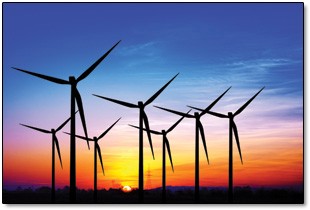Bigger Means Greener

By Brianne McCurley
WindmillsContrary to popular belief that going “green” means to occupy a smaller apartment or own a smaller automobile, the larger the wind turbine, the greener it is. The size of wind turbines is now reaching 420’ â that’s longer than a football field. Wind turbines have quadrupled in size over the past 30 years. A report published in the American Chemical Society’s journal, Environmental Science & Technology, reviewed the energy it took to build, transport, maintain and dispose of large wind turbines. The study found that larger models become more sustainable over time because they produce larger amounts of energy than smaller turbines. Only the turbines are growing in size; the supports and motors remain the same, thus cutting down on production costs.
The lead author of the study, Marloes Caduff of the Zurich Institute of Environmental Engineering, said she was surprised at how much the carbon footprint declined over time. The study found that as manufacturing wind turbines doubled, the global warming potential per kilowatt-hour of electricity dropped 14 percent. Wind turbines will continue to grow in size as the industry grows and companies become more efficient with production.
The United States and China have some of the largest wind farms in the world. In the future, wind farms may decrease in size due to the higher-capacity models producing more energy. Fewer turbines and less acreage will be required to create the same amount of energy. An additional way that wind turbines are green is that the electricity they produce does not lead to any harmful emissions. Wind is a renewable resource â a clean and safe source of power.
Did You Know?
- Wind is caused by the uneven heating of the Earth’s surface by the sun
- The United States’ largest wind farm in Texas has 627 turbines that sit on 100,000 acres; it produces 781.5 megawatts, which delivers enough energy to power 265,000 homes
- In 200 B.C. the first recorded uses of wind power were to pump water and grind grain
- The early windmills in Europe were turned on a horizontal axis instead of a vertical one
Classroom Discussion
- Discuss the difference between renewable resources and non-renewable resources
- What other renewable resources are used for energy production?